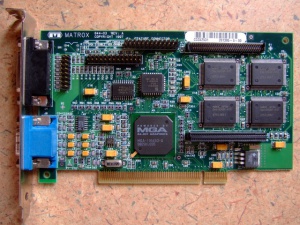Difference between revisions of "Matrox Mystique"
(categories) |
|||
| Line 45: | Line 45: | ||
[[Category:Hardware]] | [[Category:Hardware]] | ||
| − | [[Category: | + | [[Category:Graphics Cards]] |
Latest revision as of 07:42, 12 March 2013
Matrox Mystique is a 2D/3D/video accelerator for PC. Matrox released their first Mystique on August 14, 1996. Newer versions, including Mystique 220, kept appearing until summer 1997. The videocard usually had 2-4 Mb SGRAM expandable to 8MB with a special memory add-on card. However, apart from higher resolutions, upgrading memory did not make much difference.
Mystique was oriented on mid-end consumer and business market, offering excellent 2D performance, traditional for Matrox. It also has basic 3D capabilities, delivered mainly through Matrox Simple Interface API. As for the 2D part, it's safe to say the videocard has no known flaws. The image is crisp, has fine colors. But the 3D part is not as good as 2D. Its major flaws are:
- absence of texture filtering
- absence of mipmapping
- crude alpha-blending and environmental mapping emulation
- performance issues.
Basically, it means that:
- pixels of low-resolution textures have sharp edges
- distant textures appear noisy
- glass, fog, smoke, etc. appear as a check pattern of fully transparent/opaque pixels, environment (like underwater) is frequently not implemented at all.
- many early Direct3D titles are barely playable.
Matrox Mystique had its own advantages. It outran its competitors (S3 ViRGE, ATI Mach64) in 2D. It still accelerated 3D graphics a great deal, and, although the picture was close to software rendering, Mystique worked on calculating 3D instead of the CPU, which was already under heavy load. For a friendly price it offered gamers, who could not afford a 3dfx Voodoo, a playable framerate on some 3D titles, which was more than enough. Indeed, if one learns to deal without alpha-blending and proper environment mapping, Mystique brings its owner a nice crisp image with bright colors. In games, where it's not crucial (Tomb Raider, for example), the picture can be described as curious and overall not bad. Due to its good 2D performance and lower than average 3D capabilities, it is common practice to put Mystique in pair with a 3dfx Voodoo Graphics to combine fast 2D with widely supported and almost perfect 3D.
Today: Mystique is a nice 2D choice to run alongside 3dfx Voodoo and as a secondary 3D accelerator for wider 3D experience.
Matrox Simple Interface API compatible games
Thanks to vetz, we can enjoy this list of games, that work with Matrox Mystique API (MSI):
- Actua Soccer (does not work on Mystique 220)
- Battle Arena Toshinden (does not work on Mystique 220)
- Destruction Derby 2
- Croc
- Mechwarrior 2: Mystique Edition
- Monster Trucks (Thunder Truck Rally)
- Scorched Planet
- Screamer II
- Screamer Rally
- Time Warriors
- Tomb Raider
- UEFA Champions League 1996/1997
For more information on the supported games, see forum thread
Mystique 220
Original Matrox Mystique has 170 MHz RAMDAC and is based on MGA 1064 GPU. The later version, Mystique 220, has 220MHz RAMDAC and is based on MGA 1164 GPU. Other than that, there is basically no difference between two versions of the card. The major problems of Mystique were never resolved.
However, benchmarking concludes that Matrox kept including minor changes in Mystique without informing the customers, so later Mystique versions, like the one made by Compaq (on the picture above), can have 220 MHz RAMDAC and identify themselves as Mystique 220 while having old 1064 GPU.

